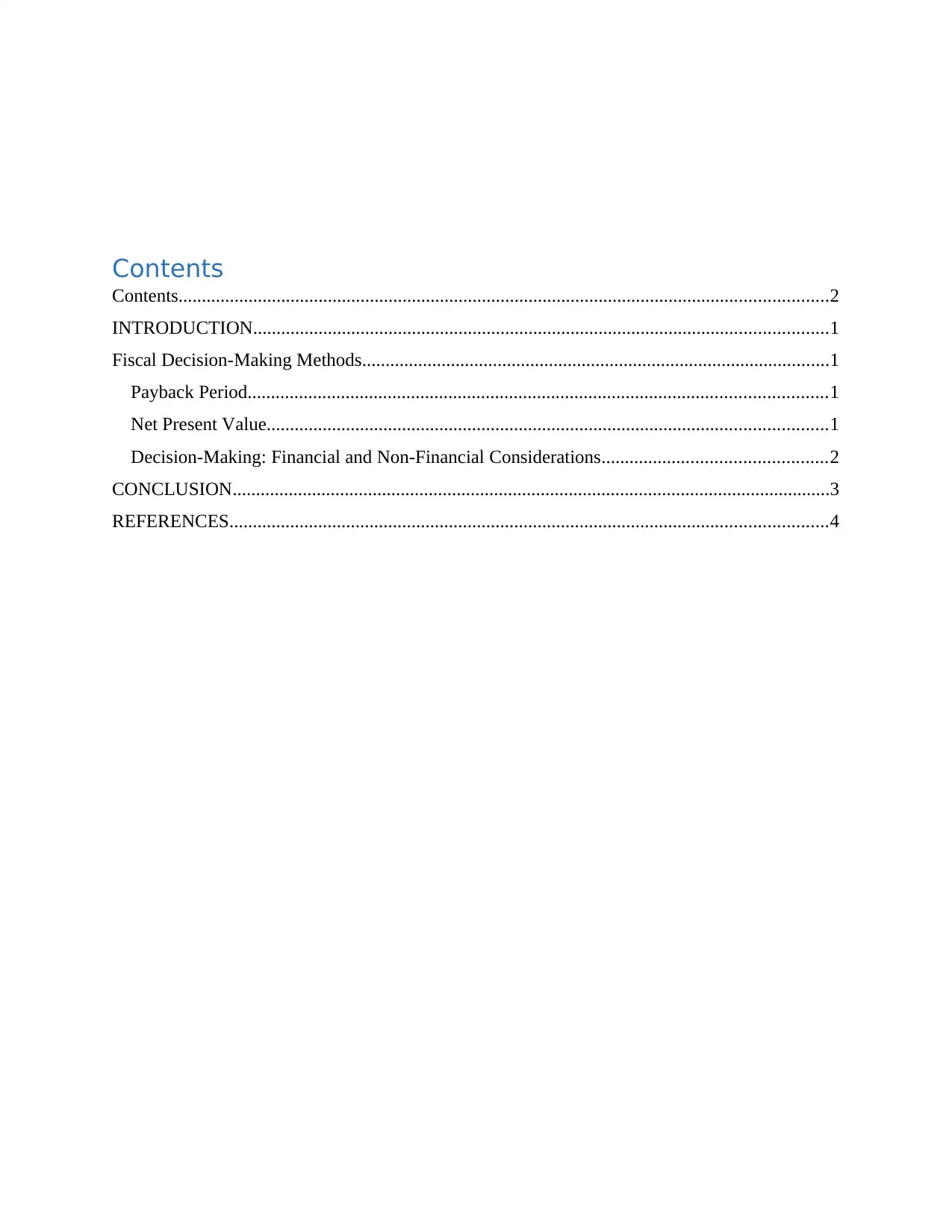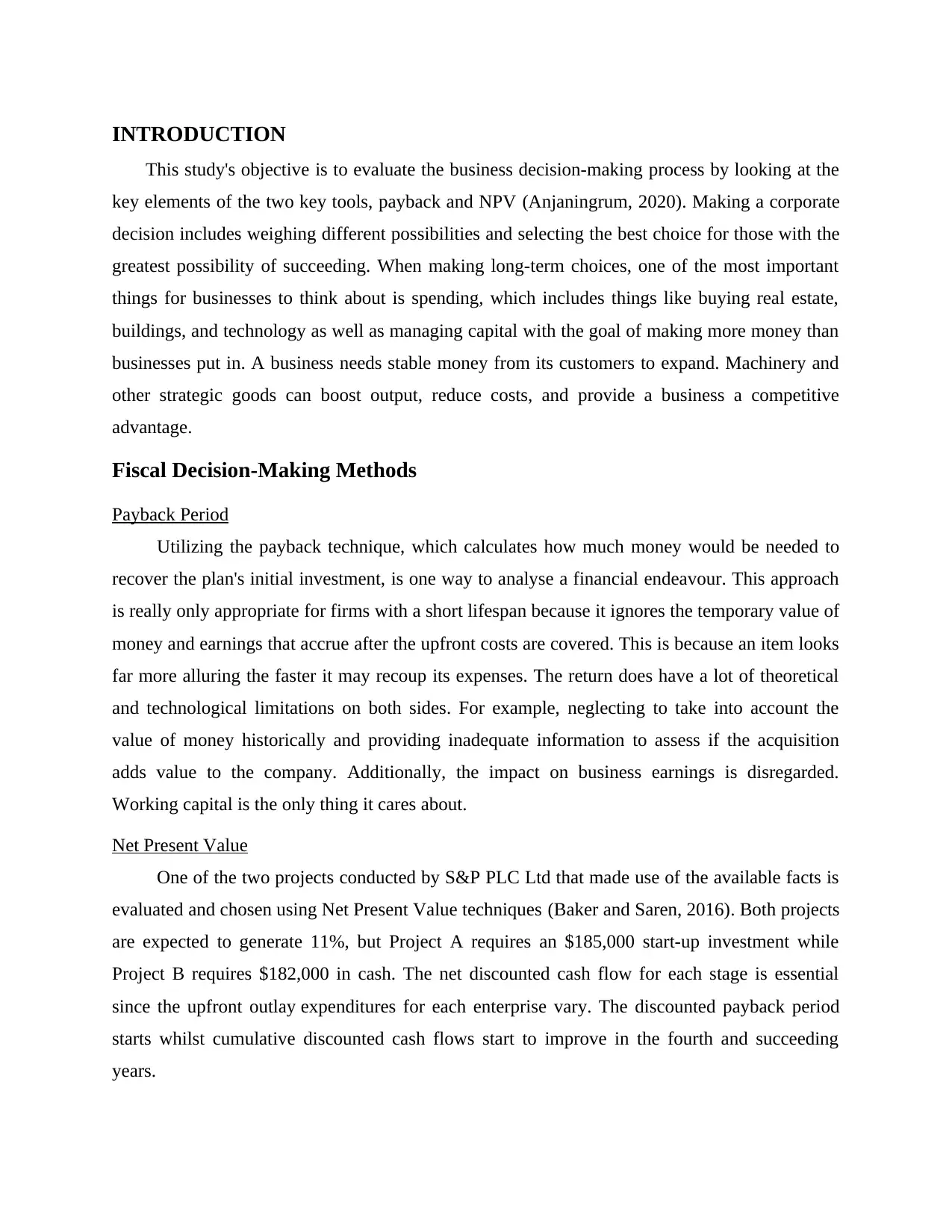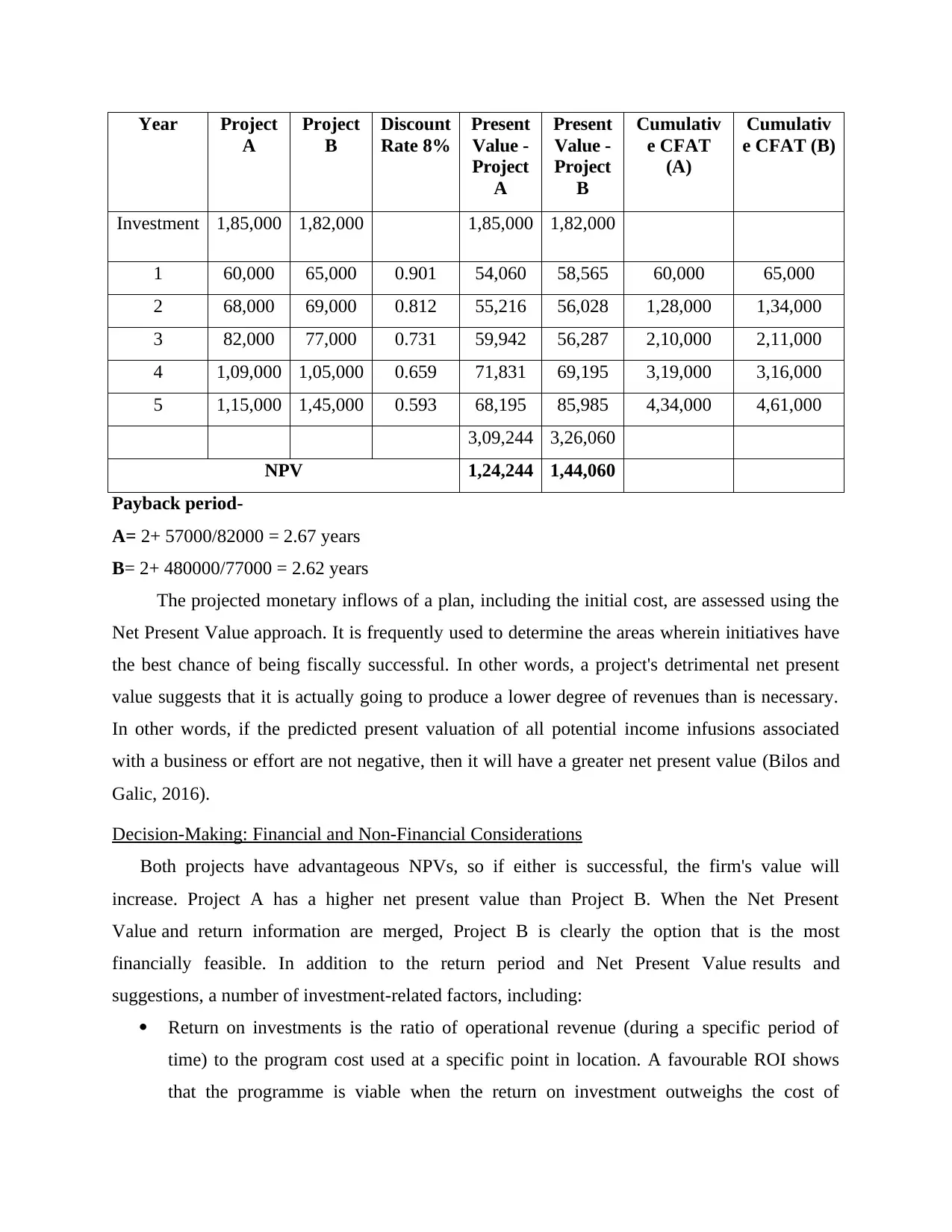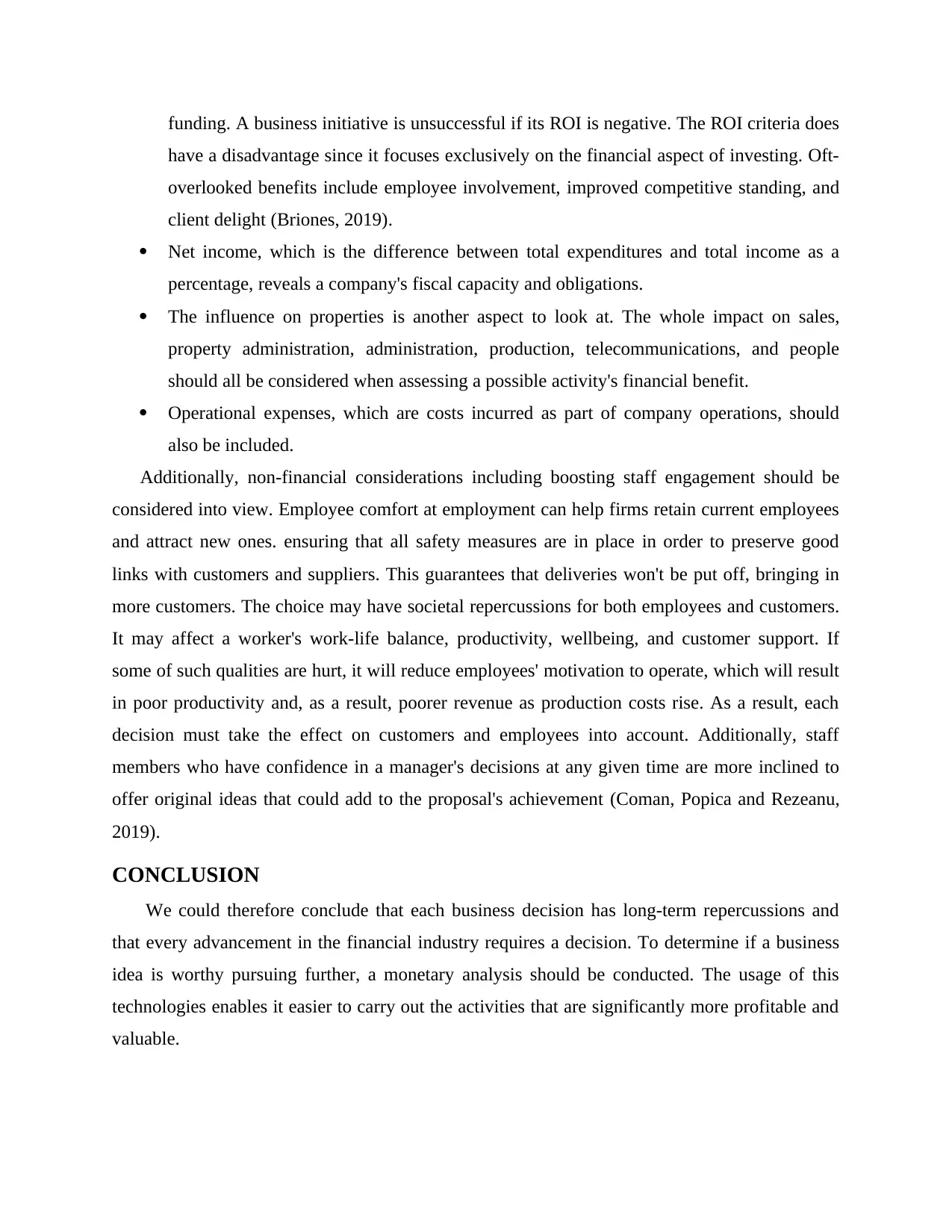Report on Business Decision-Making Process: Tools, Methods, Analysis
VerifiedAdded on 2023/06/07
|7
|1333
|378
Report
AI Summary
This report delves into the intricacies of business decision-making, evaluating the process through the lens of key financial tools such as the payback period and Net Present Value (NPV). It explores how businesses assess investment opportunities and make choices that maximize their chances of success. The report analyzes fiscal decision-making methods, demonstrating the application of payback period and NPV calculations to evaluate project profitability. Furthermore, it highlights the importance of considering both financial and non-financial factors in the decision-making process, including return on investment, net income, operational expenses, and the impact on employees and customers. By examining these elements, the report underscores the long-term implications of business decisions and the significance of conducting thorough financial analyses to support strategic choices. The report uses the example of two projects and their financial performance to illustrate the practical application of NPV and payback period in making informed decisions, ultimately concluding that each business decision requires a comprehensive evaluation to ensure financial viability and long-term success.

Business Decision
Making
Making
Paraphrase This Document
Need a fresh take? Get an instant paraphrase of this document with our AI Paraphraser

Contents
Contents...........................................................................................................................................2
INTRODUCTION...........................................................................................................................1
Fiscal Decision-Making Methods....................................................................................................1
Payback Period............................................................................................................................1
Net Present Value........................................................................................................................1
Decision-Making: Financial and Non-Financial Considerations................................................2
CONCLUSION................................................................................................................................3
REFERENCES................................................................................................................................4
Contents...........................................................................................................................................2
INTRODUCTION...........................................................................................................................1
Fiscal Decision-Making Methods....................................................................................................1
Payback Period............................................................................................................................1
Net Present Value........................................................................................................................1
Decision-Making: Financial and Non-Financial Considerations................................................2
CONCLUSION................................................................................................................................3
REFERENCES................................................................................................................................4

⊘ This is a preview!⊘
Do you want full access?
Subscribe today to unlock all pages.

Trusted by 1+ million students worldwide

INTRODUCTION
This study's objective is to evaluate the business decision-making process by looking at the
key elements of the two key tools, payback and NPV (Anjaningrum, 2020). Making a corporate
decision includes weighing different possibilities and selecting the best choice for those with the
greatest possibility of succeeding. When making long-term choices, one of the most important
things for businesses to think about is spending, which includes things like buying real estate,
buildings, and technology as well as managing capital with the goal of making more money than
businesses put in. A business needs stable money from its customers to expand. Machinery and
other strategic goods can boost output, reduce costs, and provide a business a competitive
advantage.
Fiscal Decision-Making Methods
Payback Period
Utilizing the payback technique, which calculates how much money would be needed to
recover the plan's initial investment, is one way to analyse a financial endeavour. This approach
is really only appropriate for firms with a short lifespan because it ignores the temporary value of
money and earnings that accrue after the upfront costs are covered. This is because an item looks
far more alluring the faster it may recoup its expenses. The return does have a lot of theoretical
and technological limitations on both sides. For example, neglecting to take into account the
value of money historically and providing inadequate information to assess if the acquisition
adds value to the company. Additionally, the impact on business earnings is disregarded.
Working capital is the only thing it cares about.
Net Present Value
One of the two projects conducted by S&P PLC Ltd that made use of the available facts is
evaluated and chosen using Net Present Value techniques (Baker and Saren, 2016). Both projects
are expected to generate 11%, but Project A requires an $185,000 start-up investment while
Project B requires $182,000 in cash. The net discounted cash flow for each stage is essential
since the upfront outlay expenditures for each enterprise vary. The discounted payback period
starts whilst cumulative discounted cash flows start to improve in the fourth and succeeding
years.
This study's objective is to evaluate the business decision-making process by looking at the
key elements of the two key tools, payback and NPV (Anjaningrum, 2020). Making a corporate
decision includes weighing different possibilities and selecting the best choice for those with the
greatest possibility of succeeding. When making long-term choices, one of the most important
things for businesses to think about is spending, which includes things like buying real estate,
buildings, and technology as well as managing capital with the goal of making more money than
businesses put in. A business needs stable money from its customers to expand. Machinery and
other strategic goods can boost output, reduce costs, and provide a business a competitive
advantage.
Fiscal Decision-Making Methods
Payback Period
Utilizing the payback technique, which calculates how much money would be needed to
recover the plan's initial investment, is one way to analyse a financial endeavour. This approach
is really only appropriate for firms with a short lifespan because it ignores the temporary value of
money and earnings that accrue after the upfront costs are covered. This is because an item looks
far more alluring the faster it may recoup its expenses. The return does have a lot of theoretical
and technological limitations on both sides. For example, neglecting to take into account the
value of money historically and providing inadequate information to assess if the acquisition
adds value to the company. Additionally, the impact on business earnings is disregarded.
Working capital is the only thing it cares about.
Net Present Value
One of the two projects conducted by S&P PLC Ltd that made use of the available facts is
evaluated and chosen using Net Present Value techniques (Baker and Saren, 2016). Both projects
are expected to generate 11%, but Project A requires an $185,000 start-up investment while
Project B requires $182,000 in cash. The net discounted cash flow for each stage is essential
since the upfront outlay expenditures for each enterprise vary. The discounted payback period
starts whilst cumulative discounted cash flows start to improve in the fourth and succeeding
years.
Paraphrase This Document
Need a fresh take? Get an instant paraphrase of this document with our AI Paraphraser

Year Project
A
Project
B
Discount
Rate 8%
Present
Value -
Project
A
Present
Value -
Project
B
Cumulativ
e CFAT
(A)
Cumulativ
e CFAT (B)
Investment 1,85,000 1,82,000 1,85,000 1,82,000
1 60,000 65,000 0.901 54,060 58,565 60,000 65,000
2 68,000 69,000 0.812 55,216 56,028 1,28,000 1,34,000
3 82,000 77,000 0.731 59,942 56,287 2,10,000 2,11,000
4 1,09,000 1,05,000 0.659 71,831 69,195 3,19,000 3,16,000
5 1,15,000 1,45,000 0.593 68,195 85,985 4,34,000 4,61,000
3,09,244 3,26,060
NPV 1,24,244 1,44,060
Payback period-
A= 2+ 57000/82000 = 2.67 years
B= 2+ 480000/77000 = 2.62 years
The projected monetary inflows of a plan, including the initial cost, are assessed using the
Net Present Value approach. It is frequently used to determine the areas wherein initiatives have
the best chance of being fiscally successful. In other words, a project's detrimental net present
value suggests that it is actually going to produce a lower degree of revenues than is necessary.
In other words, if the predicted present valuation of all potential income infusions associated
with a business or effort are not negative, then it will have a greater net present value (Bilos and
Galic, 2016).
Decision-Making: Financial and Non-Financial Considerations
Both projects have advantageous NPVs, so if either is successful, the firm's value will
increase. Project A has a higher net present value than Project B. When the Net Present
Value and return information are merged, Project B is clearly the option that is the most
financially feasible. In addition to the return period and Net Present Value results and
suggestions, a number of investment-related factors, including:
Return on investments is the ratio of operational revenue (during a specific period of
time) to the program cost used at a specific point in location. A favourable ROI shows
that the programme is viable when the return on investment outweighs the cost of
A
Project
B
Discount
Rate 8%
Present
Value -
Project
A
Present
Value -
Project
B
Cumulativ
e CFAT
(A)
Cumulativ
e CFAT (B)
Investment 1,85,000 1,82,000 1,85,000 1,82,000
1 60,000 65,000 0.901 54,060 58,565 60,000 65,000
2 68,000 69,000 0.812 55,216 56,028 1,28,000 1,34,000
3 82,000 77,000 0.731 59,942 56,287 2,10,000 2,11,000
4 1,09,000 1,05,000 0.659 71,831 69,195 3,19,000 3,16,000
5 1,15,000 1,45,000 0.593 68,195 85,985 4,34,000 4,61,000
3,09,244 3,26,060
NPV 1,24,244 1,44,060
Payback period-
A= 2+ 57000/82000 = 2.67 years
B= 2+ 480000/77000 = 2.62 years
The projected monetary inflows of a plan, including the initial cost, are assessed using the
Net Present Value approach. It is frequently used to determine the areas wherein initiatives have
the best chance of being fiscally successful. In other words, a project's detrimental net present
value suggests that it is actually going to produce a lower degree of revenues than is necessary.
In other words, if the predicted present valuation of all potential income infusions associated
with a business or effort are not negative, then it will have a greater net present value (Bilos and
Galic, 2016).
Decision-Making: Financial and Non-Financial Considerations
Both projects have advantageous NPVs, so if either is successful, the firm's value will
increase. Project A has a higher net present value than Project B. When the Net Present
Value and return information are merged, Project B is clearly the option that is the most
financially feasible. In addition to the return period and Net Present Value results and
suggestions, a number of investment-related factors, including:
Return on investments is the ratio of operational revenue (during a specific period of
time) to the program cost used at a specific point in location. A favourable ROI shows
that the programme is viable when the return on investment outweighs the cost of

funding. A business initiative is unsuccessful if its ROI is negative. The ROI criteria does
have a disadvantage since it focuses exclusively on the financial aspect of investing. Oft-
overlooked benefits include employee involvement, improved competitive standing, and
client delight (Briones, 2019).
Net income, which is the difference between total expenditures and total income as a
percentage, reveals a company's fiscal capacity and obligations.
The influence on properties is another aspect to look at. The whole impact on sales,
property administration, administration, production, telecommunications, and people
should all be considered when assessing a possible activity's financial benefit.
Operational expenses, which are costs incurred as part of company operations, should
also be included.
Additionally, non-financial considerations including boosting staff engagement should be
considered into view. Employee comfort at employment can help firms retain current employees
and attract new ones. ensuring that all safety measures are in place in order to preserve good
links with customers and suppliers. This guarantees that deliveries won't be put off, bringing in
more customers. The choice may have societal repercussions for both employees and customers.
It may affect a worker's work-life balance, productivity, wellbeing, and customer support. If
some of such qualities are hurt, it will reduce employees' motivation to operate, which will result
in poor productivity and, as a result, poorer revenue as production costs rise. As a result, each
decision must take the effect on customers and employees into account. Additionally, staff
members who have confidence in a manager's decisions at any given time are more inclined to
offer original ideas that could add to the proposal's achievement (Coman, Popica and Rezeanu,
2019).
CONCLUSION
We could therefore conclude that each business decision has long-term repercussions and
that every advancement in the financial industry requires a decision. To determine if a business
idea is worthy pursuing further, a monetary analysis should be conducted. The usage of this
technologies enables it easier to carry out the activities that are significantly more profitable and
valuable.
have a disadvantage since it focuses exclusively on the financial aspect of investing. Oft-
overlooked benefits include employee involvement, improved competitive standing, and
client delight (Briones, 2019).
Net income, which is the difference between total expenditures and total income as a
percentage, reveals a company's fiscal capacity and obligations.
The influence on properties is another aspect to look at. The whole impact on sales,
property administration, administration, production, telecommunications, and people
should all be considered when assessing a possible activity's financial benefit.
Operational expenses, which are costs incurred as part of company operations, should
also be included.
Additionally, non-financial considerations including boosting staff engagement should be
considered into view. Employee comfort at employment can help firms retain current employees
and attract new ones. ensuring that all safety measures are in place in order to preserve good
links with customers and suppliers. This guarantees that deliveries won't be put off, bringing in
more customers. The choice may have societal repercussions for both employees and customers.
It may affect a worker's work-life balance, productivity, wellbeing, and customer support. If
some of such qualities are hurt, it will reduce employees' motivation to operate, which will result
in poor productivity and, as a result, poorer revenue as production costs rise. As a result, each
decision must take the effect on customers and employees into account. Additionally, staff
members who have confidence in a manager's decisions at any given time are more inclined to
offer original ideas that could add to the proposal's achievement (Coman, Popica and Rezeanu,
2019).
CONCLUSION
We could therefore conclude that each business decision has long-term repercussions and
that every advancement in the financial industry requires a decision. To determine if a business
idea is worthy pursuing further, a monetary analysis should be conducted. The usage of this
technologies enables it easier to carry out the activities that are significantly more profitable and
valuable.
⊘ This is a preview!⊘
Do you want full access?
Subscribe today to unlock all pages.

Trusted by 1+ million students worldwide

REFERENCES
Books and journals
Anjaningrum, W.D., 2020, October. Efektivitas Digital Marketing dan Networks Dalam
Mendongkrak Kinerja Pemasaran UKM Di Masa Pandemi Covid-19. In SENABISMA:
Prosiding Seminar Nasional Bisnis dan Manajemen (Vol. 5, pp. 50-61).
Baker, M.J. and Saren, M. eds., 2016. Marketing theory: a student text. Sage.
Bilos, A. and Galic, T., 2016. The role of digital marketing in university sport: An overview
study of higher education institution in Croatia. Ekonomski Vjesnik, 29(2), p.453.
Briones, C.L.T., 2019. Digital Marketing as a Communication Tool in Emerging Businesses. In
Handbook of Research on Digital Marketing Innovations in Social Entrepreneurship
and Solidarity Economics (pp. 353-366). IGI Global.
Coman, C., Popica, M.M. and Rezeanu, C.I., 2019, October. The Adoption of Digital Marketing
by SMEs Entrepreneurs. In The 2018 International Conference on Digital Science (pp.
431-441). Springer, Cham.
Books and journals
Anjaningrum, W.D., 2020, October. Efektivitas Digital Marketing dan Networks Dalam
Mendongkrak Kinerja Pemasaran UKM Di Masa Pandemi Covid-19. In SENABISMA:
Prosiding Seminar Nasional Bisnis dan Manajemen (Vol. 5, pp. 50-61).
Baker, M.J. and Saren, M. eds., 2016. Marketing theory: a student text. Sage.
Bilos, A. and Galic, T., 2016. The role of digital marketing in university sport: An overview
study of higher education institution in Croatia. Ekonomski Vjesnik, 29(2), p.453.
Briones, C.L.T., 2019. Digital Marketing as a Communication Tool in Emerging Businesses. In
Handbook of Research on Digital Marketing Innovations in Social Entrepreneurship
and Solidarity Economics (pp. 353-366). IGI Global.
Coman, C., Popica, M.M. and Rezeanu, C.I., 2019, October. The Adoption of Digital Marketing
by SMEs Entrepreneurs. In The 2018 International Conference on Digital Science (pp.
431-441). Springer, Cham.
1 out of 7
Related Documents
Your All-in-One AI-Powered Toolkit for Academic Success.
+13062052269
info@desklib.com
Available 24*7 on WhatsApp / Email
![[object Object]](/_next/static/media/star-bottom.7253800d.svg)
Unlock your academic potential
Copyright © 2020–2025 A2Z Services. All Rights Reserved. Developed and managed by ZUCOL.





